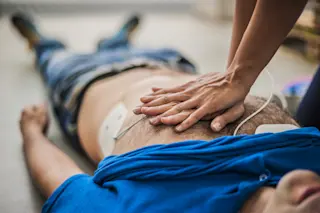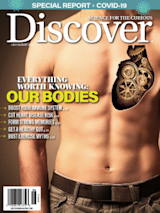This story appeared in the July/August 2020 issue as "When Hearts Attack." Subscribe to Discover magazine for more stories like this.
“911, what’s your emergency?” The call from dispatch alerts Cleveland EMS to a 57-year-old man with chest pain. The firefighters drop what they’re doing, while paramedic Kayla DeVor and her partner board the ambulance. The whole team is out of the station in less than a minute. Everything is in place for any emergency they may face, and they arrive on the scene in under nine minutes. The paramedics are already working as they approach the patient to determine whether he is conscious, whether he is breathing and how well he can respond to questions. DeVor asks, “Hey, sir, how’s it going? When did your symptoms start? What were you doing when the pain started?” As the team continues to get crucial information on the man’s condition and history of heart disease, diabetes and hypertension, they take his vitals.
DeVor hooks up an electrocardiogram, or EKG, which tracks the heart’s electrical activity. By now, the paramedics have been on the scene for five minutes, an eternity in the world of emergency medicine.
DeVor scans the markings on the strip of paper scrolling out of the EKG monitor. The patterns change shape during a heart attack, and not all of them signal the same level of emergency. Today, though, she sees the telltale signs of the most serious kind of heart attack. A major coronary artery, the heart’s own blood supply, is completely blocked, depriving the heart of oxygen and other nutrients. The longer this patient goes without treatment, the greater the damage to his heart muscle. Cardiologists have a saying for this: “Time is tissue.”
Mindful of every minute, DeVor transmits the EKG results to the hospital and alerts the ER team that the patient is on the way. They load him into the ambulance, where DeVor hooks up oxygen and starts an IV while her partner gives him four 80-milligram tablets of baby aspirin and, since his blood pressure is too high, nitroglycerin to relieve his chest pain.
They head to the ER and, after a quick stop in a trauma room, a cardiac team whisks the patient to a specialized radiology room for a cardiac catheterization. Even though the EKG confirmed a bad heart attack, doctors still have to figure out which vessels are blocked and pinpoint wounded cardiac tissue. This procedure will allow the cardiologist to find out how bad the damage is and treat blockages in the coronary arteries, fast.
Getting patients to the cath lab, called door-to-balloon, in 90 minutes or less is critical. Oxygen-starved cells die off fast. “Dead heart muscle from severe damage becomes scar tissue, so the heart pump often will fail to work well from that point forward if not treated quickly,” says Nicholas Ruthmann, a staff cardiologist at the Cleveland Clinic in Ohio. That’s why, he says, “We sometimes call the cath lab ‘the table of truth.’"
Once in the cath lab, the cardiologist, guided by X-ray, snakes a balloon-tipped catheter through a blood vessel — in this case, in the patient’s groin — up to his heart. A contrast dye is injected so the blockages will show up on a monitor. This image, called an angiogram, is currently the best way to find blocked vessels in the heart. The cardiologist inflates the balloon, which smashes the plaque against the walls of the coronary artery, sending much-needed blood to the heart. In an artery that’s completely blocked, the cardiologist places a stent, a wire mesh that holds the artery open and keeps blood flowing to the heart.
Most hospitals report back on patients whom paramedics bring to the ER to tell them whether the treatment was successful. And this time, our 57-year-old is going to be just fine. “That is a fantastic part of our job,” says DeVor. “Seeing how what we did actually made a difference in a heart attack.”
Total Attack of the Heart
The plaque that builds up on the inner lining of our blood vessels — atherosclerotic plaque — is a byproduct of our body’s best intentions. Our cells need lipids (fats), but they don’t dissolve in water. So, to travel through the bloodstream, they ball up into spheres called lipoproteins: tiny globes with cholesterol and triglycerides in the middle and proteins on the outside.
But at some point, perhaps from microscopic damage to the inner vessel lining, the low-density versions of these lipoproteins (nicknamed “bad cholesterol”), which shuttle cholesterol through your arteries, can get trapped along with white blood cells and other molecules. Over decades, this gunk morphs into plaque with a crusty outer layer and a cheesy inner layer, eventually squeezing off blood flow and starving the heart of oxygen and nutrients.
Today, more and more people are surviving heart attacks — over 90 percent — thanks in part to clot-busting drugs, angiograms and cardiac care units. But these people still have damaged hearts and, ultimately, still need more medical care. And despite this seemingly high survival rate, heart disease remains the leading cause of death for men and women. That’s why health care professionals ask us to tackle controllable risk factors on our own.
Hypertension, diabetes, sedentary lifestyle, stress, high body mass index (or weight-to-height ratio, BMI) and waist circumference (a touchy subject, says Christina Adams, an integrative cardiologist at Scripps Clinic in La Jolla, California), all contribute. Smoking ups the risk because chemicals from cigarettes narrow vessels by inflaming the cells that line them. And, more recently, researchers have discovered that depression, lack of restorative sleep and sleep apnea all contribute to heart disease. The risk escalates even more after stressful events, such as the death of a loved one or a job loss.
Beyond that, there are disparities in risk based on where we live, our gender, and our racial and ethnic background. Black people and women are more likely to experience heart failure than white men of a similar age — and they’re more likely to die from it, either in the hospital or within five years. Risk escalates for women post-menopause. And residents of the rural South are at higher risk for heart attacks as well. Part of what ups these risks is air pollution and socioeconomic factors: Researchers have even found that ZIP codes are one of the best predictors for heart attack survival — a critical finding for minority and undeserved communities.
The disparities that drive treatment and survival rates are all the more worrisome because changes in diet and lifestyle can help prevent heart attacks, which are actually the endpoint of a very severe disease, says Adams. “I like to empower people and say, ‘Look, you can do something about this every day. You have a chance to improve your health even in your 50s and 60s — even in your 70s.’”
The Heart of a Woman
Women and men experience heart disease differently, from risk factors to symptoms. While the most common symptom is chest pain, women are more likely to have pain in the arms, jaw or back, as well as experience fatigue, dizziness, indigestion and nausea. Some studies suggest that women also experience more “silent heart attacks,” which can happen with subtle or no symptoms.
Common risk factors like smoking and diabetes are more potent in women, and researchers are slowly understanding why. One common denominator is the rise in blood pressure, or hypertension, that these factors cause, says Susan Cheng, a cardiologist and population researcher at Cedars Sinai in Los Angeles.
In a study published in 2020 in JAMA Cardiology, Cheng’s team analyzed repeated blood pressure data collected over 43 years in people ages 5 to 98. The researchers compared an individual’s blood pressure with their younger selves and tracked those changes over decades.
Cheng compared women with women and men with men, something researchers hadn’t done before. The results showed that women’s blood pressure accelerates over their lifetimes faster than it does in men, and that acceleration starts earlier in life. “It was eyeopening to us,” says Cheng.
Cheng says this speed-up may come down to anatomy. Women’s coronary arteries have a relatively smaller diameter than men’s, even after correcting for body size, which also may make them more sensitive to other risk factors, such as sedentary lifestyle, high salt intake, obesity and high cholesterol. And that explains why smoking is a bigger risk factor for heart disease in women: Cigarette smoke exposes the cells lining our arteries to toxic chemicals, making them ground zero for vascular disease, including hypertension.
This could mean that doctors may need to be more aggressive in treating younger women with borderline high blood pressure, says Cheng, and make younger to middleaged adults more aware that high blood pressure is not just a condition of older age.
What Me, Worry?
When it comes to maintaining a healthy lifestyle, we’re our own worst enemies. Adams says it’s typically obvious why patients have heart attacks — except to the patients themselves. “They’re in denial. Their response is often, ‘I can’t believe this happened. I didn’t have any symptoms. I am healthy.’ ” In response, Adams is usually able to pull up electronic medical records and show them, for example, how their weight has increased 2 pounds every year for the last five years. She shows them years of unaddressed, borderline high blood pressure and high triglycerides.
For patients who do worry about their risk, Adams may suggest a coronary calcium scan, sometimes called “mammography for the heart.” These specialized scans help assess risk by providing a three-dimensional reconstruction of the coronary arteries and a calcium score. The calcium-rich outer layer of built-up plaque lights up on the scan. Seeing the calcium on their arteries is often enough incentive to adopt preventive measures, says Adams.
The coronary CT scans are helpful, but limited, because they don’t show soft, inner plaque. More recently, researchers have begun using the fat surrounding coronary arteries to scan for heart health. This perivascular fat lights up differently on a CT scan in areas where arteries are inflamed, which is where plaque tends to form. Results of a 2018 study published in The Lancet showed the fat could predict those at risk for dying of heart disease.
Even if researchers keep finding new ways of pinpointing signals of heart disease at its earliest stages, though, people still need to heed the call and change their lifestyles. Getting people to listen means reframing the message from cardiovascular disease to cardiovascular health, presenting heart disease as something preventable rather than as a problem they must learn to live with, says Vasan Ramachandran, principal investigator and director of the Framingham Heart Study, a multigenerational study begun in 1948 at Boston University to find common contributing factors to heart disease.
Ruthmann says he takes a practical approach to encourage heart health. He asks patients to consider their prized possessions. “You wouldn’t be careless with a new diamond engagement ring, your grandfather’s watch he wore all his life or a brand-new car. No, you admire and take extra care of those things.
“Take care of your heart the same way,” he says. “It’s truly something we can’t live without.”
Jeanne Erdmann is a health and science writer who lives near St. Louis.















